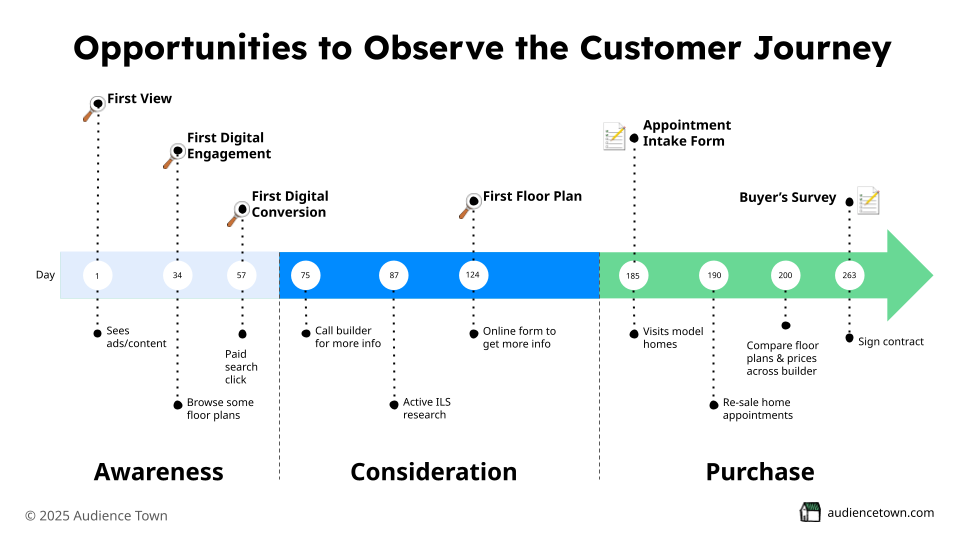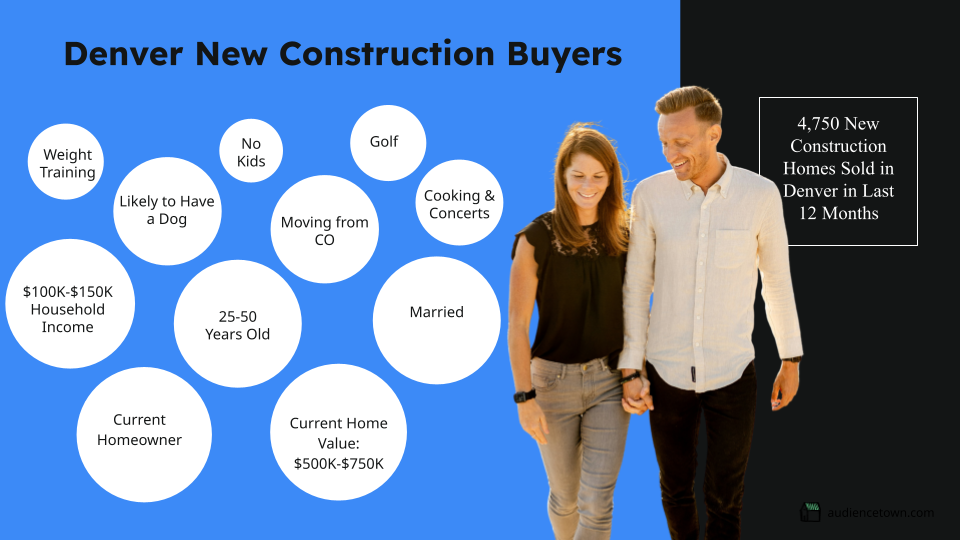Today’s home buyers are in the lead, and their journey looks nothing like your sales process. According to Audience Town’s home buyer journey data, most buyers take 200+ days to move from first click to contract. Over half never fill out a form.
Meanwhile, builders are still marketing like it’s 2015: relying on lead forms, CRM snapshots, and launch dates that don’t match how buyers actually shop.
This gap leads to wasted spend, poor lead quality, and missed sales. The good news? The home buyer is knowable — if you’re looking in the right places.
This post breaks down the disconnect and shows how knowing your buyer can help you close the gap and sell more homes.
Part 1: The Gap
The home buyer is in control. And yet, many home builders are still stuck marketing like it’s 2015.
Still measuring success by lead form submissions? Still sending the same email campaign to every prospect regardless of their behavior? Still treating your model home launch as the start of the home buyer journey?
That’s marketing like it’s 2015.
Here’s the disconnect: today’s home buyer is shopping across Zillow, Instagram, Google, YouTube, TikTok, and Meta, and they expect a homebuying experience that mirrors the rest of their digital life. But most builders are still aligning their sales and marketing strategy to internal stages of development: when the model is open, when the first release drops, when spec inventory needs to move.
The truth? The home buyer journey doesn’t follow your sales calendar. It doesn’t wait for your grand opening. It’s more digital, more dynamic across channels, and longer than you probably think. And it almost never happens in a straight line.
What Today’s Home Buyer Journey Actually Looks Like
According to Audience Town’s proprietary home buyer journey data, the average new construction buyer takes 200+ days to move from first digital interaction to contract signing. One real-world timeline tracked over a dozen touchpoints: paid search click, floor plan views, ILS research, model home tours, comparison shopping, and eventually, contract.
Here is a representative example from a builder in our platform:
- 25% of buyers research for 3–8 months before filling out a contact form
- 60% of paid search traffic comes from repeat visitors
- Pet-friendly home and neighborhood features influenced both ad clickthrough rates and appointment bookings.
The home buyer journey starts earlier, is more digital, and is more dynamic than you might think.

Demographics matter too. As we presented at the Sales & Marketing Leadership Summit in Denver, our Market Assessment solution shows that:
- 70% of new construction home buyers are moving from within Colorado
- Most are 25–50 years old, married, without children
- Interests include cooking, golf, live concerts, and fitness
- 41% of new construction buyers own at least one dog
- Household income often falls between $100K–$150K.
- They’re current homeowners with a property value of ~$500-$700k.

This isn’t a funnel. It’s a squiggle. A messy, personal, emotionally-driven squiggle that can’t be fully captured by a static lead form or a last-click attribution model. Your CRM can only tell you part of the story. The rest is hidden in the digital noise.
And for your marketing to be successful, and your sales to be consistent, you need to understand the squiggly journey bringing your home buyers to your active communities.
The Builder Lifecycle Is Structured—But Often Out of Sync
Meanwhile, builders are operating within their own internal lifecycle: surveys and strategy, site development, soft launch, grand opening, momentum phase, close-out.
It’s a logical and necessary process. But it rarely aligns with what the home buyer is experiencing.
You might be kicking off your pre-sales campaign. But your ideal home buyer? They’re on month six of passive research and still not ready to talk.
You might be pushing for end-of-quarter closings. But your home buyers are comparing mortgage estimates, stuck in emotional indecision, or ghosting due to unclear messaging.
The community sales lifecycle assumes consistent momentum. But home buyers don’t move in a straight line. They move when life changes.
Why the Disconnect Happens
Most builders still rely heavily on form-driven data: surveys, CRM fields, buyer feedback. Some are even starting to see AI-generated form entries. But much of the home buyer’s decision-making happens before any form is submitted.
Home buyers leave signals across platforms:
- In Google searches for best neighborhoods
- On Zillow with saved properties and map views
- On Instagram and Facebook, engaging with floor plan photos and lifestyle content
- In video watch times for virtual walkthroughs
And they’re not always moving quickly. Our home buyer journey data consistently shows that many buyers spend 200+ days researching before they convert.
More critically? They’re sometimes - but not always - filling out forms. Our home buyer journey data indicates that 55% of buyers never filled out a form anywhere.
That’s six or more months of untracked, high-intent behavior happening outside your CRM.
This anonymous digital behavior is where the real story lives. And builders who rely only on CRM snapshots are missing the context they need to market better and sell more homes.
.gif)
Part 2: Closing the Gap
This gap is close-able. And forward-thinking builders are doing just that.
We’ve seen clients:
- Reallocate budget from paid search to social after discovering it drove more new visitor conversions per dollar
- Justify upper-funnel budget by showing how brand engagement fed into lead-to-contract conversions months later
- Adjust ad creative to feature pet-friendly features, leading to measurable lift in engagement and tour requests
- Integrate CRM and marketing performance data to understand which channels actually found the buyers
The key shift is mindset: stop trying to pull buyers into your process. Start listening to theirs.
3 Things Builders Can Do Now to Align with the Modern Home Buyer
Here are a few things you can do get a better grip on modern marketing that aligns with the home buyer journey:
- Audit your marketing funnel: Where are buyers dropping off? Where are they re-engaging? Do you know which channels are actually working to deliver good leads?
- Incorporate behavioral insights: Go beyond demographics to tailor messaging to actual interests and search behavior.
- Rethink quantity vs. quality: While sales teams may still push for "more leads," real results come from betterleads. Are you reaching buyers who are financially and emotionally ready to move?
If you’re not sure how to do this, we can help. This—and more—is exactly what Audience Town is built to do for you.
Knowing Your Home Buyer Isn’t Optional
You can’t manufacture demand. But you can know your buyer.
You have 200-300 days and dozens of touchpoints to get it right. Each one is a chance to connect…or a chance to miss.
At Audience Town, we help builders:
- Leverage Market Assessment to profile buyers by market, down to behaviors and demographics
- Use Foundation to track true marketing performance across all digital channels
- Deploy the Attribution Bundle to connect marketing and CRM data, lead by lead, channel by channel
The modern home buyer journey is complex, but not unknowable.
When you know your audience, you make better decisions. And when you make better decisions, you sell more homes.
.gif)
.png)

.png)
.png)